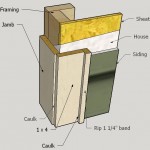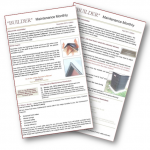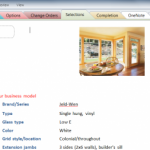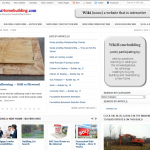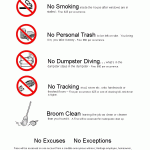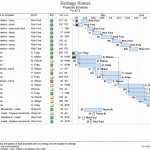Performance Standard: HBR articles 11-7, 16-18, 16-19, 16-20, 16-21 Click icon to view book 
Drywall will be free from obvious material defects at the time of the final walk through.
Variations in texture of drywall is normal and will occur randomly.
CORRECTIVE MEASURE: NONE
Drywall joints may be uneven. This is a natural condition that occurs with randomly applied materials.
CORRECTIVE MEASURE: NONE
Texture on sand-painted or textured ceilings may be uneven. This is a normal condition that occurs with randomly applied materials.
CORRECTIVE MEASURE: NONE
Cracks greater than 1/8” will be repaired, one time only, during the warranty period (1/8″ = 2 pennies).
THIS REPAIR DOES NOT INCLUDE REPLACEMENT OF PAINTING, WALLPAPER, WALL OR FLOOR COVERING UNLESS NOTED FOR CORRECTION ON THE FINAL INSPECTION BEFORE POSSESSION FORM.
Note
Truss uplift: HBA article 11-7 The trusses on your home are engineered in accordance with the Trust Plate Institute (TPI), which is the accepted standard of New York State. A direct result of today’s highly energy-efficient homes is Truss Uplift. This condition is caused by a number of inter-related factors: Vapor barriers in ceilings; heavy insulation and well-vented attic areas. With the bottom cord buried in 10 to 13 inches of insulation, the moisture is not allowed to enter or escape as freely as it does in the top cord. The result being the top cord moves and the bottom cord does not, therefore, arching may occur. This may further cause drywall to crack between wall and ceiling.
The cracking will often show up as a separation between the wall and the ceiling. The separation will be wider in the winter and may close completely in the summer. The cycle may also repeat year after year. Repairing the separation with joint compound may be less effective than caulking.
Repair of truss uplift separations is not included in the one year drywall coverage.
Homeowner Operation and Maintenance
Repairs – With the exception of the one-time repair service provided by BUILDER, care of drywall is a homeowner maintenance responsibility. Most drywall repairs can be made easily. It may work best to do your drywall repairs when you redecorate the room.
Repair hairline cracks with a coat of paint. You can repair slightly larger cracks with spackle or caulk. To correct a nail pop, reset the nail with a hammer and punch. Cover it with joint compound, which is available at paint, and hardware stores and home centers. Apply two or three thin coats. When dry, sand the surface between coats with medium-grain sandpaper, and then paint. You can fill indentations caused by sharp objects in the same manner.
Sand-Painted Ceilings – The sand-painted ceilings in your home are easy to maintain: periodically remove dust or cobwebs as part of your normal cleaning and repaint as needed.
BUILDER Limited Warranty Guidelines
During the final walk through, we confirm that drywall surfaces are in acceptable condition.
One Year Drywall Repairs – One time during the warranty period, BUILDER will repair drywall shrinkage cracks and nail pops greater than 1/8 inch width, visible from six feet under normal lighting conditions. Any issues that are repaired on sand-painted ceilings will be repainted by the drywall company. Only the effected area will be sand-painted and a perfect match to existing ceiling paint should not be expected. Repainting of repaired walls is a homeowner responsibility.
Lighting Conditions – BUILDER does not repair drywall flaws that are only visible under particular lighting conditions.
Related Warranty Repairs – If a drywall repair is needed as a result of poor workmanship (such as blisters in tape) or other warranty-based repair (such as a plumbing leak), BUILDER completes the repair by touching up the repaired area with the same paint that was on the surface when the home was delivered. If more than one-third of the wall is involved, we will repaint the wall corner to corner. You are responsible for custom paint colors and/or wallpaper that has been applied subsequent to closing. The effects of time on paint and wallpaper, as well as possible dye lot variations, mean touch-up may not match the surrounding area.
